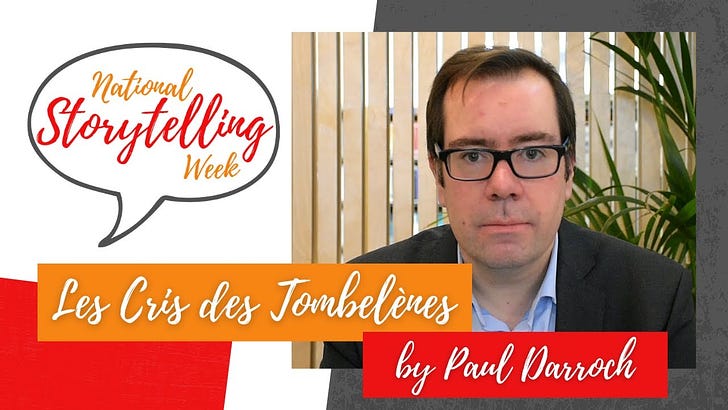Jersey, as we know, is rich in myths and legends. When I was invited to tell one of them in my own words for National Storytelling Week, I leapt at the chance.
I decided to recount the ancient Jersey tale of Les Cris des Tombelènes. My inspiration was the classic 1880 version by Carolus P (as adapted by Ahier) but I completely re-imagined and re-wrote the story in my own words. Thanks to Ed, Marc and the team at Jersey Library for the opportunity to bring this medieval legend to life.
The YouTube video is below. I hope you enjoy it ~ Paul Darroch
How do I decide what to write next? I’m often inspired by walking around St Helier and imagining what the area I’m passing through looked like in previous centuries. One street that has some hidden stories to tell is Colomberie. Read on to discover its eventful and dramatic history.
Colomberie: Story of a Street
by Paul Darroch
Colomberie is a street of ghosts. It began life as a little path wending through rich orchards, in the grounds of a square-towered manor house. Le Manoir de la Motte boasted the privilege of keeping two pigeon-houses, or colombiers. The birds were allowed to fatten themselves freely on the fields, and the penalty for poaching one was a hefty fine. So the footpath nearby was probably named for them; it soon became a track, and eventually a thoroughfare, the main road heading in to St Helier from the east.
And so it was that when a French army landed at La Rocque on a winter’s night in 1781, it marched right through Colomberie. The invaders had made landfall unseen, a phantom army sweeping in from the sea. Suddenly at Colomberie, they were spotted. A young girl, Elizabeth Messervy, called down from a window: ‘Ou donc la garde?’ (‘Where are the guards?’). The invaders laughingly replied: ‘Elle dorme, ma chérie’ (‘They are sleeping, my dear’). Their surprise attack on St Helier was almost complete. At Snow Hill, householder Pierre Arrivé rushed out in alarm and was brutally bayoneted to death. The first casualty of the Battle of Jersey had fallen.
Yet Jersey survived, and Colomberie thrived. The remaining orchards were gradually swallowed up by houses. So let us now take a walk down the street in its late nineteenth century heyday, at the height of Jersey’s Victorian age.
At the head of Colomberie lie the sprawling grounds of Plaisance, a grand estate. A small boy named Tom has dared to go foraging for chestnuts in its gardens this morning. He is soon scolded by the owner, locked in a cellar and forced to clean his boots as a punishment. Seething with anger, he boldly declares that one day he will return as a rich man, buy the house and destroy it stone by stone. Decades later, T.B. Davis will return and keep his word. In its place he will establish a park, named after his son, Howard, who died on the Western Front.
Now the bustle of Colomberie opens up before you. Two sisters, Elinor and Lucy, are growing up restlessly at No. 55, in the shadow of their drunken stepfather. Elinor loses herself in books; Lucy takes to sewing little dresses for her dolls. These two little girls will grow up to change the world; Elinor Glyn will sell millions of romantic novels and Lucy Duff-Gordon will become a pioneering couturier.
‘La Colomberie’ boasts a particularly ornate exterior; it belongs to the family of William Fruing, a former Barnardo’s Boy who made a fortune in the cod trade. A century later it will lie buried under the Colomberie Court arcade. Then at the heart of the street, we catch a glimpse of Colomberie House itself, home of the Hemery family of wine-merchants. This impressive building features alterations by Sir John Soane and its Golden Drawing Room, named after its gilded Louis XV furniture, is the parlour of high society. Sadly, in over a century’s time, it will be demolished to make way for offices.
We are now approaching the heart of St Helier, past the shop-fronts with their copperplate lettering and exotic wares. As we near the south end of Colomberie, we hear the unmistakeable whistle of a steam train. We have arrived at Snow Hill, the terminus of the Jersey Eastern Railway. The story that began with a track through the orchard has ended at a gleaming Victorian station.
Ask if you must: but no-one can point to the two round stone pigeon-houses that many say gave Colomberie its name. They are already lost in the mists of time, and have vanished without trace.
If you enjoy my writing you will discover much more in Jersey: The Hidden Histories and Jersey: Secrets of the Sea. My two books are available on Amazon UK in paperback and Kindle form, and also in Jersey shops such as Waterstones, WH Smith (top floor) and the Harbour Gallery. Thank you for reading.
(c) Paul Darroch 2021



